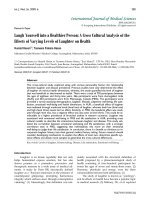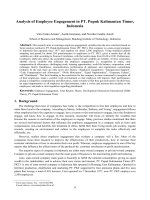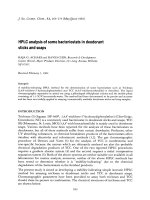analysis of four-wave-mixing effects in up stream transmission using soa as transmiter
Bạn đang xem bản rút gọn của tài liệu. Xem và tải ngay bản đầy đủ của tài liệu tại đây (708.96 KB, 4 trang )
International Journal of Scientific Engineering and Technology (ISSN : 2277-1581)
Volume No.2, Issue No.7, pp : 745-748 1 July 2013
IJSET@2013 Page 745
Analysis of Four-Wave-Mixing Effects in Up Stream Transmission Using
SOA as Transmitter
Vikram Singh Yadav, Praveen Kumar Vatsal, Ritesh Kumar
Department of Electronics and Communication, LNCTS, Bhopal M.P. India
Abstract
We demonstrate four-wave-mixing (FWM) based
wavelength modulation at 1.55 μm using SOA. For a pump
peak power of -10 dBm, a numerical simulation is used to
predict the performance of each ONU Transmitter for
different experimental conditions and to address the
potential of each SOA in wavelength modulation effects
analysing four-wave-mixing. It is shown that wavelength
conversion, covering the entire C-band, can be achieved
with different performance for SMF-28 optical fiber at
reasonable optical pump power and for different fiber
lengths.
Keywords: Four-Wave-Mixing (FWM); optical fiber
communication; nonlinear optics; wavelengthconversion.
Introduction
The field of nonlinear optics has continued to grow at a
tremendous rate since its inception in 1961 and hasproven to
be a nearly inexhaustible source of new phenomena and
optical techniques [1]. In opticalcommunication systems the
term nonlinearity refers to the dependence of the system on
power of the opticalbeam/s being launched into the fiber
cable. Nonlinear effects in optical fibers have become an
area of academicresearch and of great importance in the
optical fiber based systems. Several experiments in the past
have shownthat the deployment of high-bit-rate multi-
wavelength systems together with optical amplifiers creates
majornonlinear effects such as stimulated Raman scattering
(SRS), stimulated Brillion scattering (SBS), self-
phasemodulation (SPM), cross-phase modulation (XPM)
and four-wave-mixing (FWM) [2]. These effects
haveproven to of utility in a great number of applications
including pulse compression, solitons, optical tunabledelays,
optical switching, pulse retiming and wavelength conversion
[3].In a wavelength-routed optical network, wavelength
conversion plays a major role to reduce wavelengthblocking,
provide high flexibility and utilization of wavelength
allocation in network management, which hasbeen
investigated extensively in the past several years. An all-
optical approach of wavelength conversion isfavorable to
avoid bit-rate bottleneck and costly signal conversion
between optical and electrical domains sincecurrent
electronic processing speeds are approaching fundamental
limits near 40Gb/s [4]. Ultra-high data rateall-optical
wavelength conversion is an enabling technology for
providing wavelength flexibility, increasing thecapacity of
photonics networks and enhancing optimized all-optical
routing and switching [4-5]. Several all- optical wavelength
conversion approaches have been demonstrated, which are
based on nonlinearities insemiconductor optical amplifiers
[6], in optical fibers [7-8], in crystals [9] and so on. Among
these approaches,wavelength conversion based on the
nonlinearity of optical fibers is inherently featured of
femtosecond responsetime, low insertion loss, non-degraded
extinction radio of the signal and low-noise characteristics
[10], whichshows the promising potential of achieving
terabit-per-second performance. Nonlinear effects mainly
applied infiber-based wavelength conversion are XPM,
FWM and SPM, all of which originate from the Kerr effect
[11].Among the various nonlinear phenomena exploited for
fiber-based wavelength conversion, FWM is regarded
asadvantageous due to its transparency both in terms of
modulation format and bit rate [12]. However to make useof
this nonlinear phenomenon in optical signal processing
requires that a suitable fiber be available. So far, aFWM-
based wavelength converter has been demonstrated by using
a fabricated W-type soft glass fiber [13] orusing a highly
nonlinear photonic crystal fiber [14] or using a highly
nonlinear holey fiber [15].In this paper, we have embarked
to the authors’ knowledge for the first time four different
commercialopticalfibers to achieve a wavelength conversion
covering the entire C-band and make a comparison in
theirperformance using a numerical simulation. The
numerical simulating software is Optisystem 7.0 from
OptiwaveInc.The remainder of this paper is organized as
follows. The mathematical review is presented in Section
2.Based on the theory presented, a numerical analysis of the
wavelength conversion process is carried out inSection
3.This is followed by the main conclusion in Section 4.
2.Mathematical Review
Nonlinear phenomena
When a light signal of high power impinges on an optical
fiber, the refractive index changes in accordance withthe
power of the signal. The refractive index n may be
expressed as
n=n
0
+n
2
…………………………….1
where:
nois the linear refractive index
n
2
is the nonlinear refractive index, and
I is the power density of the signal
As a result of this, a variety of nonlinear phenomena occur
in the optical fiber, including SPM, XPM, FWM,Brillouin
International Journal of Scientific Engineering and Technology (ISSN : 2277-1581)
Volume No.2, Issue No.7, pp : 745-748 1 July 2013
IJSET@2013 Page 746
scattering, and so on [16].In a linear medium, the electric
polarization P is assumed to be a linear function of the
electric field E:
=
0
.2
where for simplicity a scalar relation has been written. The
quantity χ is termed as linear dielectric susceptibility.
At high optical intensities (which corresponds to high
electric fields), all media behave in a nonlinear fashion.
Thus Eq. (2) gets modified to
=
0
( +
2
2
+
3
3
+)…………………………….3
whereχ(2), χ(3), … are higher order susceptibilities giving
rise to the nonlinear terms. The second term on theright
hand side is responsible for second harmonic generation,
sum and difference frequency generation,parametric
interactions etc. while the third term is responsible for third
harmonic generation, intensity dependentrefractive index,
self-phase modulation, four wave mixing etc. For media
possessing inversion symmetry χ (2) iszero and there is no
second order nonlinear effect. Thus silica optical fibers,
which form the heart of today’scommunication networks, do
not possess second order nonlinearity [17].
Theory of FWM
The origin of FWM process lies in the nonlinear response of
bound electrons of a material to an applied opticalfield. In
fact, in order to understand the FWM effect, consider a
WDM signal, which is sum of n monochromaticplane
waves. The electric field of such signal can be written as
=
cos
. .4
=1
Then the nonlinear polarization is given by
=
0
3
3
.5
For this case
takes the form as
=
0
3
cos
=1
=1
=1
.6
The reason behind this phase mismatch is that, in real
fibersk(3ω) ≠3k(ω) so any difference like (3ω −3k) is called
as phase mismatch. The phase mismatch can also be
understoodas the mismatch in phase between different
signals traveling within the fiber at different group
velocities. All these waves can be neglected because they
contribute little. The last term represents phenomenon of
four-wavemixing [3].
Fig.1. FWM of two wave ω1and ω2
Figure 1 shows a simple example of mixing of two waves at
frequency ω1 and ω2. When these waves mixed up,they
generate sidebands at ω3 and ω4 such that (ω1+ ω2=ω3+ω4)
[18]. Similarly, three co-propagating waveswill create nine
new optical sideband waves at frequencies given by Eq. (8).
These sidebands travel along withoriginal waves and will
grow at the expense of signal-strength depletion.In general
for N wavelengths launched into fiber, the number of
generated mixed products M is,
M=(N
2
/2)(N1)…… ………7
3.Results&Discussion
The modulation was based on SOA different commercial
optical fibers which are: SMF-28 single mode fiber.We
initially used the same parameters as in [12] forthe pump
power, signal power and fiber length. Two continuous-wave
(CW) lasers, tuned inside the C-band,were used as the pump
and signal sources. In order to achieve peak pump powers of
the order of a few dBmwith a moderate average-power fiber
amplifier, the pump was modulated using a Mach-
Zehndermodulator with rectangular pulses. The modulated
pump and the CW signal beams were amplified by
twoseparatefiber amplifiers and combined through an ideal
multiplexer. This configuration allowed us to independently
control the power of the two beams, and also ensured
thatnonlinear interaction of the two signals occurred only in
the applied fiber. The peak power of the pump into thefiber
was -10 dBm, while the power of the signal was .In order to
compare the performance of thewavelength conversion
numerical experiment, we will apply the same parameters
and conditions for the SMF-28fibers including the influence
of the length of the induced fiber. At the output of the
system, the FWMprocess between the pump and the signal
in any specific optical fiber gave rise to a FWM effects
which is highlighted by blue circle as shown in fig.2 (a) (b).
International Journal of Scientific Engineering and Technology (ISSN : 2277-1581)
Volume No.2, Issue No.7, pp : 745-748 1 July 2013
IJSET@2013 Page 747
We have repeated the same procedure for the other three
types of optical fibers and we have observed the
samebehaviour but with different optical converted signal
peak power. All results indicate that, the nonlinear effects
depend on the transmission length of the optical fiber.This is
because the longer the optical fiber, the more the light
interacts with the fiber material and the greater thenonlinear
effects. On the other hand, we have noticed that, the
behavior of the SMF-28fiber has the highest peakpower
compared to the other three types of fibers even when
changing the fiber length. This was due to therelative
advantage of the SMF-28fiber characteristics compared to
the other optical fibers.
4.Conclusion
In this paper, the performance of different ONU’s with SOA
as a commercial transmitter in a high speed FWM-based
wavelengthmodulation covering the entire C-band has been
numerically analyzed. The results show that, the SMF-
28opticalfiber has been shown to be a good candidate for
wavelength conversion compared to the other
commercialfibers. On the other hand, simulations revealed
that, by increasing fiber length from 20 Km to 50 Km for all
ONUsthe performance obtained from the system increase
FWM effects in communication link.
References
i. ]C. W. Thiel, “Four-wave mixing and
itsapplications,” />Mixing.pdf, last access
ii. Aug. 2011
iii. .
iv. GurjitKaur, and Arvind Kumar Sharda, “Nonlinear Effects and
Its Impact on Multichannel Systems,” 2nd National Conference on
v. Challenges and opportunities in Information Technology at
RIMT institute of Engineering and Technology, Punjab, pp. 1-6,
Mar.2008.
vi. S. P. Singh, and N. Singh, “Nonlinear Effects in Optical Fibers:
Origins, Management and Applications,” Progress in
ElectromagneticsResearch, PIER 73, pp. 249-275, 2007.
vii. C. H. Kwok, S. H. Lee, K. K. Chow, C. Shu, Chinlon Lin, and
A. Bjarklev, “Widely Tunable Wavelength Conversion With
ExtinctionRatio Enhancement Using PCF-Based NOLM,” IEEE
Photonics Technology Letters, vol. 17, no. 12, pp. 2655-2657, 2005.
viii. XinXiangjun, P.S. André, A.L.J. Teixeira, Ana Ferreira, Tiago
Silveira, P.M. Monteiro, F. da Rocha, and J.L. Pinto, “Detailednumerical
analysis of a four-wave mixing in dispersion-shifted fiber based all-optical
wavelength converter of 10 Gb/s single sidebandoptical signal,” Optical
Fiber Technology, vol. 12, pp. 288–295 , 2006.
ix. D. Wolfson, A. Kloch, T. Fjelde, C. Janz, B. Dagens, and M.
Renaud, “40-Gb/s all-optical wavelength conversion, regeneration,
anddemultiplexing in an SOA-based all-active Mach-Zehnder
interferometer,” IEEE Photonics Technology Letters, vol. 12, no. 3,
pp.332–334, 2000.
x. J. Yu, P. Jeppesen, and N.S.Knudsen,“80 Gbit/s pulsewidth-
maintained wavelength conversion based on HNL DSF-NOLM
includingtransmission over 80 km of conventional SMF,” Electronics
Letters, vol. 37, no. 9, pp. 577–579, 2001.
xi. J. Yu, and P. Jeppesen, “80-Gb/s wavelength conversion based
on cross-phase modulation in high-nonlinearity dispersion-shifted
fiberand optical filtering,” IEEE Photonics Technology Letters, vol. 13,
no. 8, pp. 833–835, 2001.
xii. J. Yamawaku, H. Takara, T. Ohara, K. Sato, A. Takada, T.
Morioka, O. Tadanaga, H. Miyazawa, and M. Asobe, “Simultaneous
25GHz-spaced DWDM wavelength conversion of 1.03Tbit/s
(103×10Gbit/s) signals in PPLN waveguide,” Electronics Letters, vol.
39,pp. 1144–1145, 2003.
xiii. TakuoTanemura, Jun Suzuki, Kazuhiro Katoh, and Kazuro
Kikuchi, “Polarization-Insensitive All-Optical Wavelength
ConversionUsing Cross-Phase Modulation in Twisted Fiber and Optical
Filtering,” IEEE Photonics Technology Letters, vol. 17, no. 5, pp. 1052-
1054, 2005.
xiv. Huangping Yan, Yuanqing Huang, ZihuaWeng, Yiju Wang,
Ruifang Ye, Zhaoxi Wu, and Jin Wan, "All-optical WavelengthConverter
Based on Self-Phase Modulation in Highly Nonlinear Photonic Crystal
Fiber,” SPIE, vol. 6837, no. 683714, pp. 1-9, Jan.2008.
xv. S. Asimakis, P. Petropoulos, F. Poletti, J. Y. Y. Leong, R. C.
Moore, K. E. Frampton, X. Feng, W. H. Loh, and D. J.
Richardson,"Towards efficient and broadband four-wave-mixing using
short-length dispersion tailored lead silicate holy fibers," Optics
Express,vol. 15, no. 2, pp. 596-601, Jan. 2007.
xvi. Angela Camerlingo, Francesca Parmigiani, Xian Feng,
Francesco Poletti, Peter Horak, Wei H. Loh, David J. Richardson, and
PeriklisPetropoulos, “Wavelength Conversion in a Short Length of a Solid
International Journal of Scientific Engineering and Technology (ISSN : 2277-1581)
Volume No.2, Issue No.7, pp : 745-748 1 July 2013
IJSET@2013 Page 748
Lead–Silicate Fiber,” IEEE Photonics Technology Letters, vol. 22,no. 9,
pp. 628-630, May 2010.
xvii. Peter A. Andersen, TorgerTokle, Yan Geng, Christophe
Peucheret, and PalleJeppesen, “Wavelength Conversion of a 40-Gb/s
RZDPSKSignal Using Four-Wave Mixing in a Dispersion-Flattened
Highly Nonlinear Photonic Crystal Fiber,” IEEE PhotonicsTechnology
Letters, vol. 17, no. 9, pp. 1908-1910, Sep. 2005.
xviii. Ju Han Lee, Walter Belardi, KentaroFurusawa, Periklis
Petropoulos, ZulfadzliYusoff, Tanya M. Monro, and David J.
Richardson,“Four-Wave Mixing Based 10-Gb/s Tunable Wavelength
Conversion Using a Holey Fiber With a High SBS Threshold,”
IEEEPhotonics Technology Letters, vol. 15, no. 3, pp. 440-442, Mar.
2003.
xix. JiroHiroishi, RyuichiSugizaki, Osamu Aso, MasateruTadakuma,
and TaekoShibuta, “Development of Highly Nonlinear FibersforOptical
Signal Processing,” Furukawa Review, no. 23, 2003.
xx. K. Thyagarajan, and AjoyGhatak, “Some important nonlinear
effects in optical fibers,” Guided Wave Optical Components andDevices:
Basics, Technology, and Applications, Bishnu P. Pal, Academic Press, pp.
91-121, 2006.
xxi. G. P. Agrawal, Nonlinear Fiber Optics, 4th edition, Academic
Press, Oxford, pp. 391-392, 2007.









